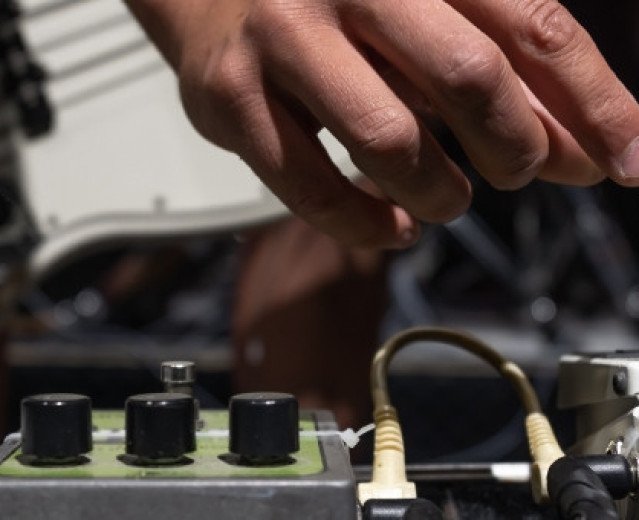Origin and description of the
different kinds of compressor pedals.
In this article you will find historical notes and an
overview of the most common types of
compressors
for electric guitar and bass. Another article on the Soundsation blog suggests a guidance to their use based on types and
musical requirements.
Audio compression
In the pro audio sector compression is the automatic
level control operation
of an electric signal (guitar sound, recorded
track, and so on), setting the
dynamic range for specific purposes. In
short, the sound levels that exceed a certain threshold are reduced, whereas
sound levels under a certain threshold are amplified. Hence a compressor is
used to adapt a signal dynamic within desired values.
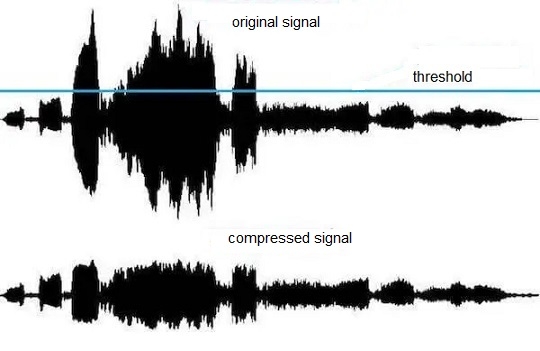
The limiter is an “extreme” compression effect
that radically limits – as the name says – a signal level, and it is used in
noise
gates
and de-essers. At some extent, a limiting effect can be
obtained also with a common compressor; very fast attack and high compression
ratio (typically 10:1) are needed. I am going to talk about this parameters
further on.
Opposite to the limiter is the expander, an
effect that increases higher signal dynamics and further reduces lower ones.
Compression parameters
The compression procedure requires setting
several
parameters:
- Threshold is the signal level (expressed in dB) above which the compressor starts
acting; in compressor pedals it is usually fixed by design.
- Ratio is the
amount of compression (expressed as a ratio, for example 4:1) that is applied
to the signal when it exceeds the Threshold value.
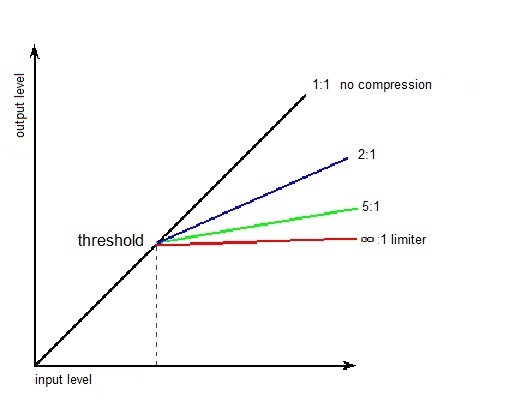
- Level is the
effect output
gain control that compensates for the compression
determined volume loss.
- Attack is the
time (expressed in milliseconds [ms]) it takes for the compression to start
acting on the signal when it exceeds the Threshold value.
- Decay is the
time (expressed in milliseconds [ms]) it takes for the compression acting since
the signal initial level to that of the set compression.
- Release is the
compressor action time (expressed in milliseconds [ms]) on the signal
until there is no more compression.
- Knee or compression curve sets out the kind of compression reaction, from sharp to gradual.
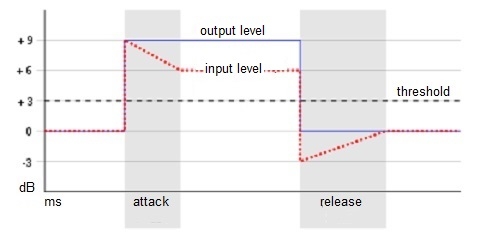
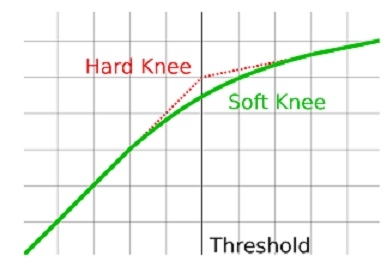
Most common compression parameters
In the studio rack-mountable compressors and DAW
(Digital Audio Workstation) plug-ins parameters can be even more, but in
the most common
compressor pedals they are usually three:
- Attack,
sometimes not present, often fixed or adjustable via a little internal
trimmer;
sometimes it is actually a Release control (ex.: Boss CS-2).
- Ratio, more
frequently called
Sustain, Compression, Comp or Sensitivity.
- Level, also
called
Volume, Output or Gain.
Less commonly, and mostly in refined bass guitar pedals, you can also find:
- Tone, to
reduce high frequencies.
- Input, to
adjust the effect
input signal level.
- Blend or Mix, to blend the original dry signal and the compressed wet (parallel compression).
As you can see, the nomenclature is rich and varied,
sometimes also used in a confused way by manufacturers. On the Internet there
are a lot of tutorials dedicated to compression and its detailed parameters in
the recording studio as well as in the
effect chains of guitar and bass
players. In this article as well as in the one dedicated to compressor uses for
guitar and bass players, we are limiting ourselves to
a practical and
schematic approach
in order to help the unsure musician in identifying the
most suitable compressor category for his/her needs.
Typology of compressors
Based on their circuits and components, compressors
can be divided in these main types:
- VCA, Voltage
Controlled Amplifier
. Examples: Boss CS-3, Keeley Comp Pro.
- OTA, Operational
Trans-conductance Amplifier
, a kind of VCA in which output current varies
instead of voltage. Examples: historic models as the MXR Dyna Comp and the Ross
Compressor, also many of the current pedals, more or less
boutique and
with more or less variations: Wampler Ego, Keeley Comp Plus, Electro-Harmonix
Tone Corset, some Nux models.
- FET, another type of VCA circuit, but based on FETs (Field Effect Transistor) and an operational IC. Examples: the historic Dan Armstrong Orange Squeezer, Electro-Harmonix Soul Preacher, Analogman Juicer.
- Optoelectronic or Optical, based on the use of bulbs or LEDs as light
sources and photo-resistors that modify the signal according to
light
intensity variations
. These compressors are slow in release, soft in attack
and produce a “warm” sound. Examples:
Diamond Compressor, Demeter Compulator,
Electro-Harmonix White Finger, Mooer Yellow Comp, BBE Opto-Stomp.
- Tube, based
on the use of tubes, usually one in pedals. Examples: Electro-Harmonix Black
Fingers, DV Mark Compressore, T-Rex Squeezer,
Effectrode PC-2A.
- Digital or DSP,
based on AD DA conversion and processing, often providing different
physical modelling simulations of
vintage compressor pedals. Examples: Boss CP-1X, TC Electronic HyperGravity,
Source Audio Atlas, Line 6 Constrictor.
A brief history of compressors
Early huge and heavy audio dynamic compression devices
appeared in recording and
broadcasting studios in the '30s and '40s of
the past century. Today '50s and '60s
tube compressors are much sought
after. In the pictures below, the Universal Audio 175B and the
Jimmy Page
popularized RCA BA-6A are showed.
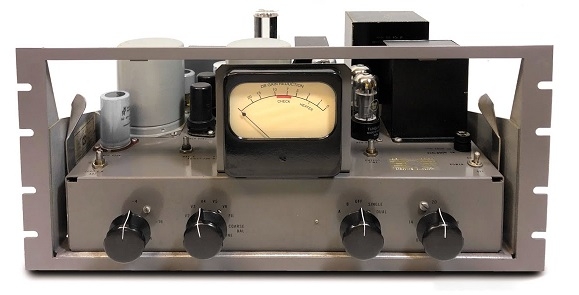

They performed according to the input signal level and
did not feature the Ratio control but just the Threshold: the higher the input
level, the more intense the compression, with a typical
soft-knee.
They are also called variable mu (µ) or
vari-mu compressors.
As
regards guitar and bass players, in the early '70s the first well known
MXR pedal effects appeared. The little
Rochester (NY) company's name was an acronym for MiXeR, because it was
specialized in those devices before dedicating to historic effects as the Phase
90 and the Distortion+. In 1972 the
Dyna Comp pedal was offered. It was based on
the noted
RCA CA3080 OTA metal IC, later a plastic one.
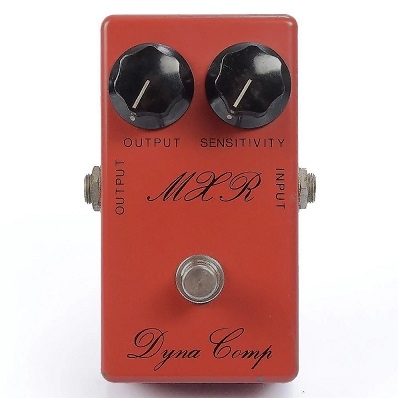
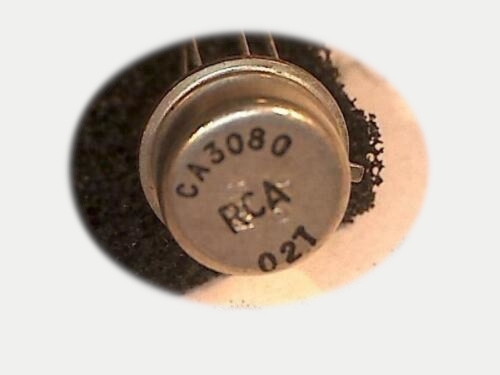
The
Dyna Comp was an immediate great success in
Nashville studios, thanks to its handiness and to the
compression quality, though a little noisy.
Largely
inspired by the MXR Dyna Comp, in 1974 the
Ross Compressor appeared, the second great name in
the history of compression stomp-boxes. It featured the same integrated used by
MXR, but it produced a slightly different sound, warmer and more laid down,
also less noisy.
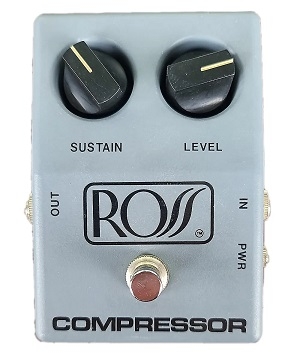
Another
'70s pioneer was guitarist and technician
Dan Armstrong, with his coloured aluminium
effects that were directly attachable to the guitar jack socket. The line
included the
Orange Squeezer, a compressor with no controls,
except for an internal trimmer setting the FET
BIAS. Transistors worked together with a
JRC4558 IC. A hole was often drilled in the box front
for a fast access to the trimmer.
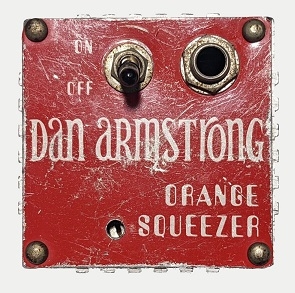
It
was at the base of the sound of guitar players as
Jeff “Skunk” Baxter (Steely Dan, Doobie Brothers), Dire
Straits'
Mark Knopfler and bass players as Tony Levin with Peter Gabriel.
The big OTA compressor family
Starting
from these early models, current and most popular compressors were developed.
As simply as possible, the MXR Dyna Comp is the classic effect for the
squeezed sound of a country solo or a funky riff.
The Ross Compressor is squashed as well, but also
milder and best usable for arpeggios and
chord melody. The Orange Squeezer is a very simple effect (on/off) and also a
little “dirty”; so is is great for boosting an amp to
saturation. The choice is a matter of tastes
and opinions...
Instead
of the old, expensive and now little available CA3080, today is often used a
modern and more performing
double trans-conductance op-amp as the LM13700, though it requires new circuit
designs.
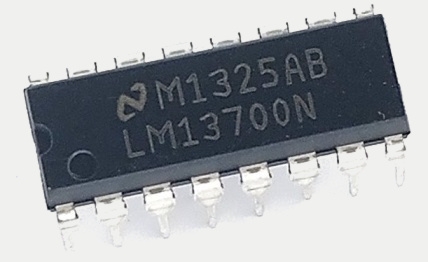
This
is the case, for example, of three
OTA compressors in the Nux effect line: the mini-pedal Sculpture NCP-2, the advanced Komp Core Deluxe (in the photo) and the Masamune NBK-5.
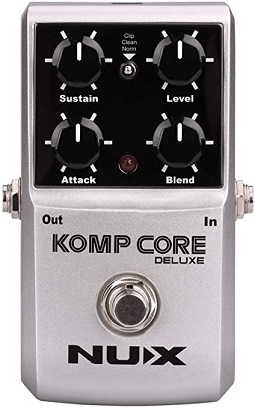
We are going to talk about these and other compressor
pedals
in the second article dedicated to compression on the Soundsation blog.
Fabrizio Dadò
References
M.Maratea, Axe Tech
column on Axe Guitar Magazine n.222 (Edizioni Palomino, September 2017)
